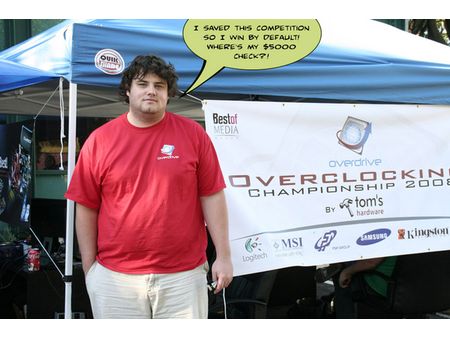Fire Dept. Crashes Our OC Event
Things arrived smoothly the day before. Equipment, liquid nitrogen tanks — all eight of them — and the competitors. Everyone was definitely gearing up and getting prepared for the event that would occur today.
Unfortunately, things would get worst before it got better. One of the building owners didn’t quite like the way we had eight giant tanks stored in our offices, and essentially told us that he would shut the entire event down — even though we offered to store the tanks outside. Clearly he was threatened by the size of our large, long, vessels.
Things were looking pretty grim for the competitors that were here. No matter, we decided to push ahead with it anyway — we’re cool like that.
Come today, we moved everything outside. All the tables were setup, and we pitched some tents and got everything going. The competitors were ready and pumped up to come over to our offices to kick start the event, but our pesky building owner came by again to put yet another damper on the competition.
"This is a fire hazard," he exclaimed.
Interestingly, liquid nitrogen displaces oxygen, and we all know what a necessary component oxygen is to sustain fires. In fact, all our giant liquid nitrogen tanks were gigantic fire extinguishers, slowly consuming the oxygen that was in the air.
We attempted to explain the situation. After what seemed like an eternity of arguing, the building manager decided to call the owner of the building, and eventually told us that the fire department would come over to "extinguish" the situation — not that there was ever a fire hazard to begin with!
Get Tom's Hardware's best news and in-depth reviews, straight to your inbox.
Fortunately, one of our competitors, Jake Crimmins from team Ironmods was there to answer all of the safety and technical questions from the fire department. Jake informed the guys in yellow that everything was safe. Working with liquid nitrogen since birth, Jake clearly knew what he was talking about.
The liquid nitrogen tanks have several safety precautions to keep dangerous situations at bay. First, there is a 22 PSI pressure valve that’s constantly and slowly releasing excess pressure. If things get really hairy, and for some unlikely situation the tanks heat up and build too much pressure, there is a 400 PSI blow off valve.
Jake also told the fire department, when asked, that the tanks should be stored next to a wall. This is of course done to prevent them from tipping over in case of an earthquake.
Clearly, the fire fighters were testing our knowledge in liquid nitrogen safety, and in no time, the fire fighters were pleased with Jake’s answers. With that, the building owner apologized to us for what he thought would be the next Chernobyl.
Overclocking begins! Next update coming soon!
Update: Update 2 now available. Fierce emotions and animal-like behavior run rampant in the competition!
-
JonnyDough Laugh. A manager has a right to be concerned, you would think you would need permits to have X amount of stored gas in any one place though. As long as they're permitted (have permits) I guess I don't see how anyone could complain. As a manager though, it is in your best interest to throw a ruckus rather than just assume it's ok. If a building does go up in flames it's your job on the line. Any building owner would want his people to watching out.Reply -
customisbetter I would hope your manager understands the labels on the side of the tanks or else he shouldn't be in a position of leadership.Reply -
altazi Nitrogen itself isn't dangerous, being a largely inert gas that makes up 78% of our atmosphere. Nitrogen doesn't "consume" oxygen; it merely displaces it when in a confined space. You could be asphixiated if you released substantial quantities of nitrogen into your confined surroundings without adequate ventilation.Reply -
radguy Just another showing of how stupid and dumb people who don't know anything and just assume stuff can really be. Its one thing to ask questions its another to just assume the worst. To compare 8 liquid nitrogen tanks to chernobyl really really really sad. Sorry you guys had to endure that.Reply -
Hmmm... why wouldn't he trust them... If i was him, I would have said... if anything goes wrong... I place the blame on you... even though thats not how things work... thats what i would have done :DReply
